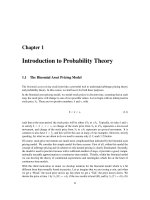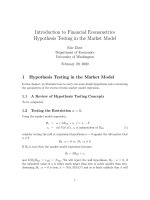Introduction to carbon materials
Bạn đang xem bản rút gọn của tài liệu. Xem và tải ngay bản đầy đủ của tài liệu tại đây (1.43 MB, 49 trang )
Introduction to Carbon Materials
Hybrid orbitals of carbon
How did we get to know about
fullerenes?
Nuclear physics researchers Hahn & Strassman in
Germany noticed that carbon cluster ions up to C15+
were produced in a high frequency arc with a graphite
electrode in the 1943.
A Japanese physical organic chemist E. G. Osawa had
perceived that carbon in the single layer closed cages
structure would be aromatic and therefore stable, in early
1970.
Gal’pern (Russian scientist) had completed the first of
many Hückel calculations showing that it would be a
closed shell molecule with a large HOMO-LUMO gap in
1973.
Fullerenes were discovered experimentally for the first
time by a group of scientists at Rice University, Houston,
Texas, in September of 1985.
Photograph of the research group that discovered the fullerenes at Rice
University in September of 1985. standing: Curl, kneeling (left to right): O’Brian,
Smalley, Kroto and Heath
Nobel Prize in chemistry in 1996
Graphite and Diamond
Graphite
•
•
•
•
•
•
•
•
•
•
Most stable form of carbon under standard conditions ( Δ H 0 = 0 kJ mol − 1
).
• Two modifi cations: hexagonal α - graphite and rhombohedral β - graphite.
• The carbon atoms are sp 2 - hybridized, σ - bonds with three adjacent
atoms
within one layer (bond angle 120 ° ). Additional delocalized π - bonds within
these layers. Only weak van der Waals interaction between the graphene
sheets.
• Considerable anisotropy of properties like electrical conductivity, modulus
of elasticity, etc due to the layered structure.
• Despite chemical inertness several compounds are known, above all
intercalation
compounds with alkali metals or halogens
.
Diamonds
•
•
•
•
Metastable modifi cation of carbon. Appears as cubic or as hexagonal
diamond ( Lonsdaleite ).
• Each C - atom is tetrahedrally connected to four adjacent atoms by σ bonds.
The C - atoms are sp 3 - hybridized.
• Greatest hardness and highest thermal conductivity among all natural
materials. Electrical insulator, yet semiconductance achievable by doping.
• Chemically extremely inert, is only attacked by aggressive reagents like
•
chromosulfuric acid
•
•
•
.
Fullerenes
Kroto and co-workers discovered an entirely new form of carbon
known as C60 or the fullerene molecule (only diamond and graphite
were known before this).
The original discovery of C60 was in the soot produced from the laser
ablation of graphite.
Only in the early 1990s fullerenes could be synthesized in large enough
quantities for significant research in this field to be undertaken.
Fullerene cages are about 7-15 angstroms in diameter ( 1A° = 1010m).
In atomic terms, their sizes are enormous.
But fullerenes are still small compared to many organic molecules.
Chemically, they are quite stable;
temperatures of over 10000 C.
breaking
the
balls
requires
At much lower temperatures (a few hundred degrees C) fullerenes will
"sublime“.
Fullerene- C60
Buckminsterfullerene (C60) has 60
carbon
atoms
arranged
in
a
spherical structure (resemblance of
this shape to the geodesic domes
designed and built by the architect
R Buckminster Fuller)
Pentagon (C5)
Hexagon (C6)
Pure C60 consists of 60 carbon atoms
arranged
as 12 pentagons and 20 hexagons.
Visually C60 it is quite different from both
graphite and diamond.
It is a yellow powder, which turns pink when
dissolved in certain solvents such as toluene.
When exposed to strong ultraviolet light, the
buckyballs polymerize,forming bonds between
adjacent balls.
In crystalline form C60 is cubic (at each
lattice
point of a cube, there is a buckyball).
It is Electrically insulating.
It shows electro-negativity and forms
compounds easily with alkali atoms.
Fullerene – C70
The rugby-ball shaped C70has 12 pentagons and 25
hexagons
Gives red colour with dichlorobenzene
With his geodetic domes, R. Buckminster Fuller provided the architectonic
inspiration for the naming of the fullerenes. The US pavilion for the Montr é al
EXPO76 is just one example ( © Montr é alais)
A previously planar aromatic structure is getting curved by the closure of a fi ve - membered ring; (b) C 60 contains
12 fi ve - membered and 20 six – membered rings showing the characters of radialenes or cyclohexatrienes, respectively. The
bonds situated between two adjacent six - membered rings are called (6,6) - bonds, those between a fi ve - and a six - membered
ring (5,6) - bonds.
The formation of a fullerene cage. The tendency toward minimizing the
number of unsaturated bonding sites causes the generation of fi ve membered rings and thus an increasing curvature and fi nal closure of the
structure to be a cage - like molecule.
Units of C60
Corannulene
Cyclohexatriene
Radialene
Isolated pentagon rule
- Energetically unfavourable pentalene, 8 π electrons can lead to
resonance destabilisation
b - meta arrangement are more favourable to avoid neighbouring
pentagons and double bonds within five membered rings
Structure and Bonding
• C60 has 12 five and 20 six membered rings
• Not all the C-C bonds of C60 is of same length
• The double bonds are localized in 6 membered
rings
• Five membered rings are evenly distributed on
the surface and isolated (Isolated pentagon rule)
• Diameter of C60 molecule is 0.702 nm
• High symmetry molecule – easily identified by
spectroscopy
Bonds in C60
Bonds between two 6 membered rings
– 6,6 bond
Bonds between 5 and 6 membered
rings – 5,6 bond
Double bonds are preferably located in
6 membered rings and it is
energetically unfavourable in 5
membered ring
Derivatizations of C60
Hetero fullerenes
Heterofullerenes – substituted with one or
more other
Atoms (N, S, B) in the place of carbon
atom
Exohedral fullerenes
•
•
•
Hydrogenated, halogenated, other functionalities by addition reactions
Exohedral fullerenes shows higher solubility
Functionalization are useful to form suprmolecular compounds
C60H
36
Exohedral fullerenes
Endohedral fullerenes
• Fullerenes filled with atoms, molecules
inside the cavity are called endohedral
fullerenes
• Metallofullerene - M@Cn ( M -Li, Ca, Sc,
Y, La, Ce, Eu)
• Nonmetallic endohedral fullerenes ( N, P)
• Noble gas containing fullerenes – X@C60
( X = He, Ne, Ar, Kr, Xe)
Method of Preparation
• Thermal method – pyrolysis of
hydrocarbons (HCs)
• Combustion – partial combustion of HCs
• Arc discharge method – graphite
• Resistance heating method
• Rational synthesis
• Pulse laser beam method - Graphite
electrodes
Thermal method - pyrolysis
• Poly aromatic hydrocarbons(PAH) are
suitable for synthesis of fullerenes by
pyrolysis
• Here the structural elements have the
structural framework of fullerene cage
• Hydrocarbons already consisting of 5 and
6 membered rings
• Napthalene, corannulenes, PAH pyrolysed
at 1000oC in an inert atmosphere.
Resistance heating method
• Here the carbon electrodes touch each other
• Small area of contact and higher current density results in strong
local heating
• Temperature reachs to 2500 – 3000 oC
• Smoke formation and cooling
• Requirement of inert (He, Ar) atmosphere (even nitrogen result in
undesirable reaction)
• Pressure should be maintained (140 – 160 mbar)
• Higher yield of fullerenes ( 15%)
• On purification, C70:C60 – 0.02:0.18
![[CEH V3] Introduction to Ethical Hacking](https://media.store123doc.com/images/document/13/ly/ap/medium_3ABUW8WdDH.jpg)








